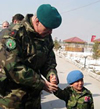Number 23 | September 14, 2007
The following is an article by Tom Mountain, published in the Jewish Advocate Online on September 12, 2007, www.thejewishadvocate.com.
The police and civilian mob came for them in the night, forcing them at gunpoint into the streets, stripping them of their property on the spot before shipping them to internment camps for expulsion. The lucky ones were put in boxcars, but most had to trudge on foot for hundreds of miles under the watchful eyes of sadistic guards that tormented their every step. The guards beat them mercilessly, shooting the stragglers, raping the women. Those with hidden jewels or money could get food, the rest starved. Death to exhaustion, disease and exposure was rampant. Already brutalized by the ravages of a long world war that destroyed their homes and livelihoods, the captives were dragged from the towns and villages they’d known for centuries to distant lands, leaving behind a trail of misery and death.
No one knows for sure how many millions suffered the long marches, or how many died as a result. Statistics weren’t kept, but the best estimate is between 500,000 and 1.1 million deaths. That’s in addition to the 300,000 to 600,000 killed during the bombings.Yet these many decades later, the perpetrators still won’t acknowledge that they committed genocide. And the victims still wait.
The Armenian tragedy?
No, the aforementioned atrocities occurred during the German tragedy in the aftermath of World War II, between 1945 and 1950, when at least a dozen European countries murdered, robbed, brutalized and expelled their German citizens. Every liberated country, from Holland to Romania, was culpable. Hungary deported most of its Germans by December 1945. The Czechs rounded up and expelled nearly 2 million, killing about 200,000 in the process. The Poles forced thousands of Germans out of East Prussia by boat; they ended up in internment camps in Denmark where 13,000 died, including 7,000 children.
If the German tragedy sounds eerily similar to the Armenian tragedy, it is. True, the German nation was the aggressor in World War II, but the Soviets and Eastern Europeans killed hundreds of thousands of German civilians under the (correct) assumption that they had been fifth column during the war – enemy combatants that posed a threat from within, just as the Armenians were to the Turks in World War I.
The Armenians of eastern Turkey, primarily Anatolia, allied themselves with Britain, France and Russia against the Ottoman Empire. Over 150,000 joined the Russian Army and fought against the Turks on the Caucasus Front, in the area of present day eastern Turkey and Armenia. The Anatolian Armenians openly rebelled against Ottoman rule, staged a guerilla war, then conspired with and fought alongside the Russians as the Tsarist army invaded eastern Turkey. This led to the decision by the Turkish government to quell the Armenian revolt, defeat the guerillas and, finally, expel the Armenians, thus causing the deaths of hundreds of thousands through famine, exposure, disease and murder at the hands of Turks, Kurds, and Circassians.
Yet the intent of the Turkish government was expulsion, not extermination. And only from those eastern provinces where Armenians were deemed a security threat. The other tens of thousands of Armenians who lived throughout the Ottoman Empire were left alone.
The European nations had to wait until Germany was defeated in 1945 before they could expel the German civilians among them, which they proceeded to do with a vengeance. The number of Germans killed by Eastern European countries equaled – and may have even surpassed – the number of Armenians killed by the Turks. And yet most of us today have never heard of the German tragedy because nations and humanitarian organizations are not clamoring to declare it genocide.
Nor are the Germans demanding that their unique tragedy be declared a genocide. But they could. In fact, based on the Armenian precedent, they ought to. As of now, the Germans have every right to expect the Anti-Defamation League to declare the German tragedy a genocide, just as they did for the Armenians. At a minimum, the ADL, as a human rights organization whose latest gimmick is expanding the category of genocide, is morally obligated to explain to the Germans why their 1945 to 1950 tragedy doesn’t qualify as genocide, despite the glaring similarities to the Armenian tragedy, especially the hundreds of thousands killed during mass expulsions.
By their foolishness in caving in to the Armenians, thus redefining genocide, the ADL has opened a Pandora’s Box, paving the way for countless victimized nations to expect the same consideration for their own historical tragedies. Even the Germans.
Tom Mountain, a Newton (MA) resident, is also a columnist for the Newton TAB.

























